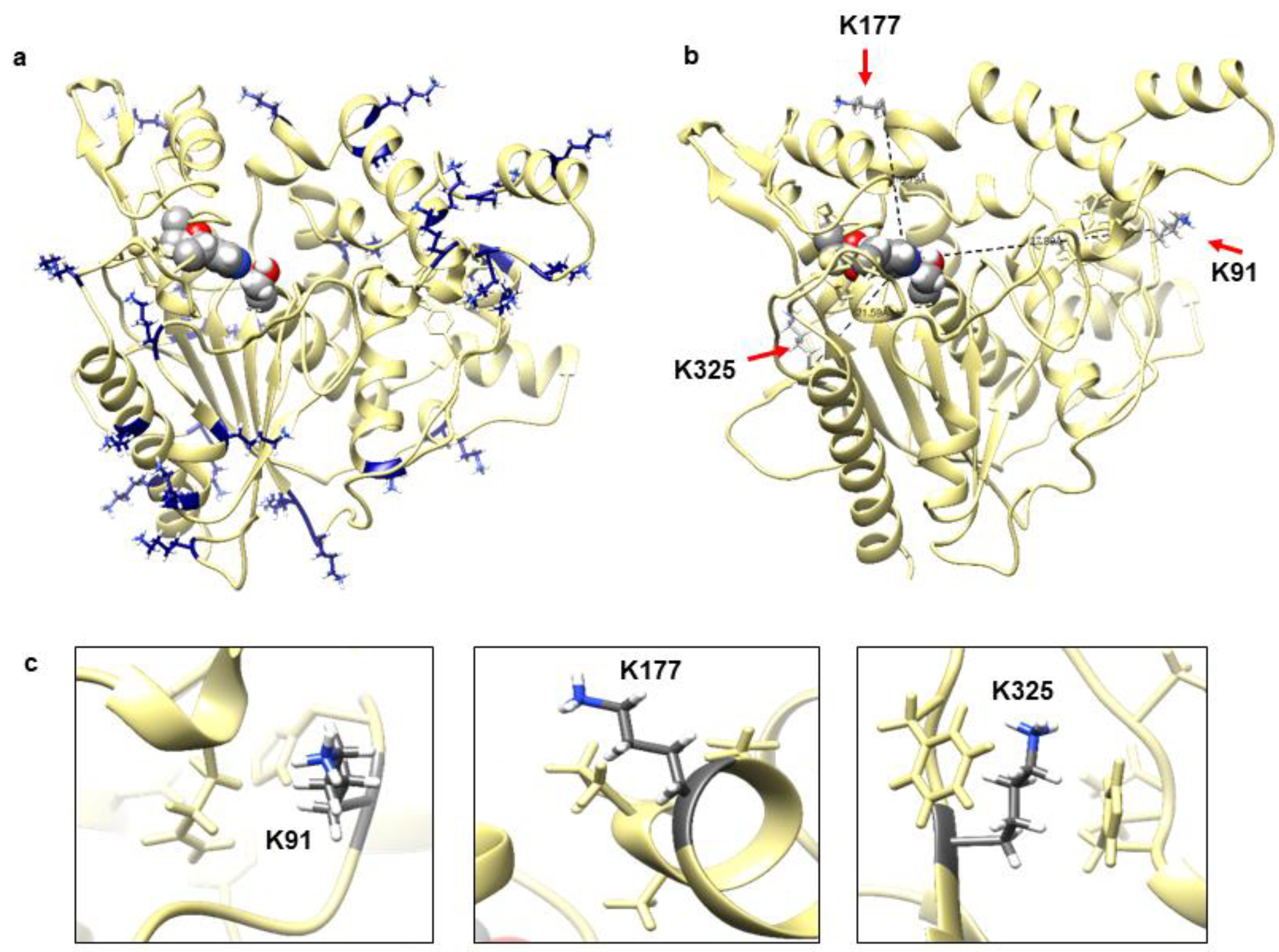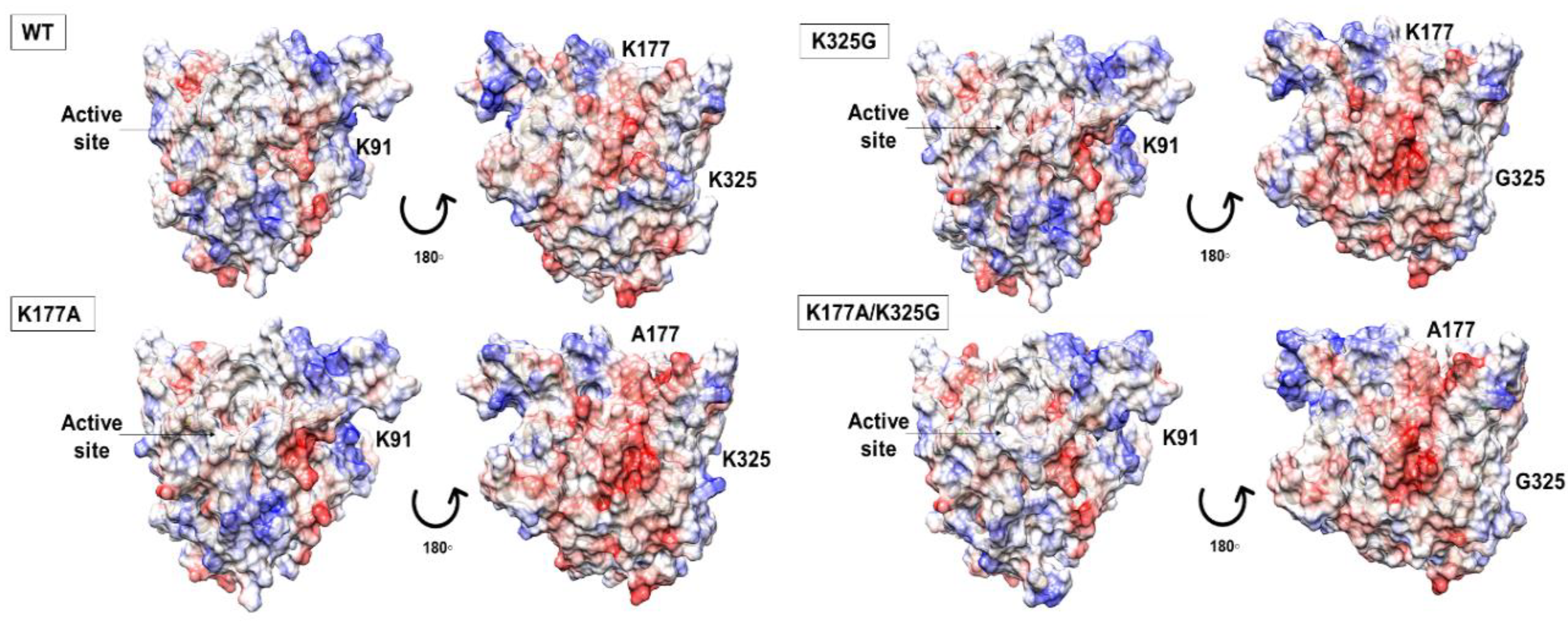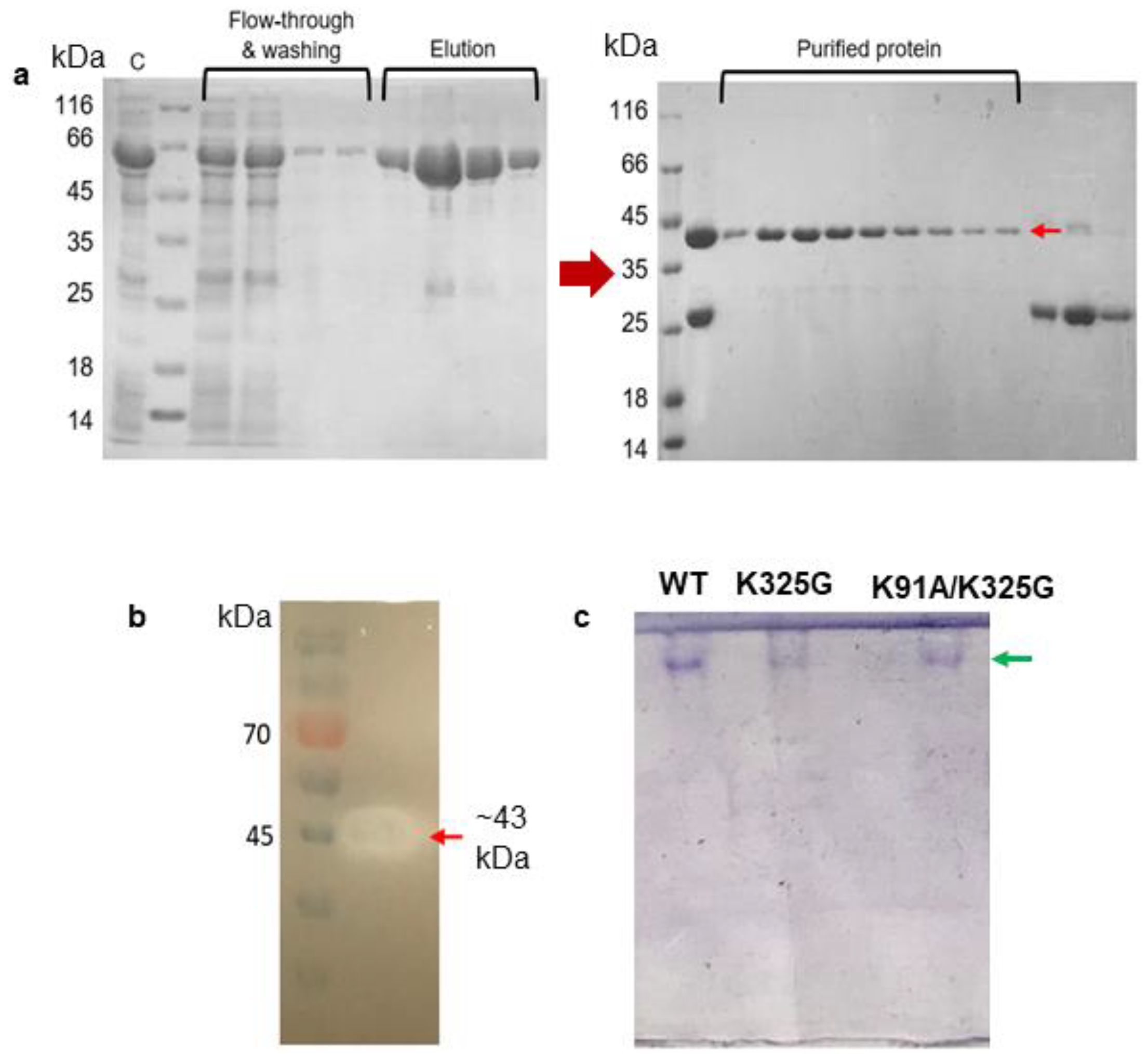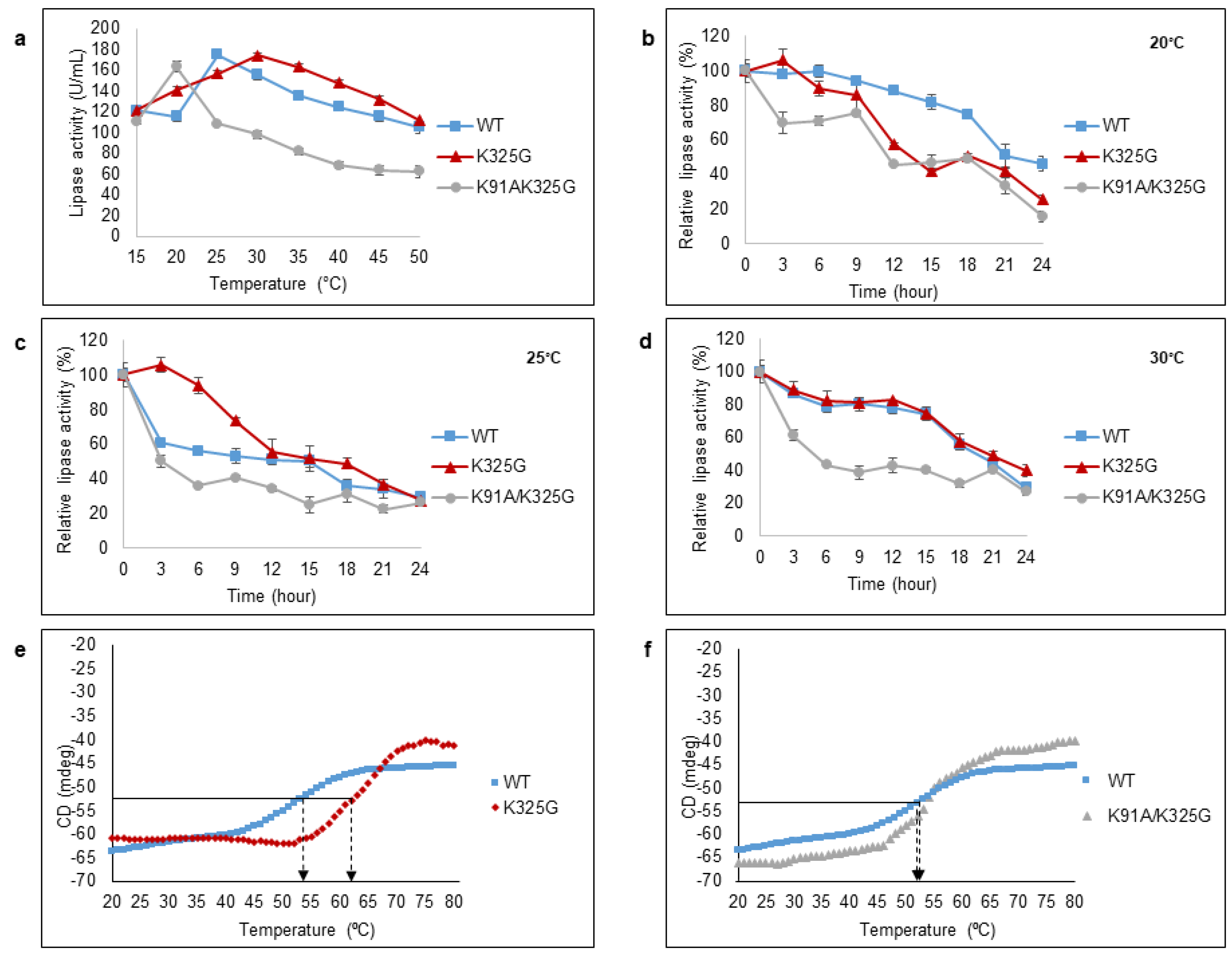The Role of Surface Exposed Lysine in Conformational Stability and Functional Properties of Lipase from Staphylococcus Family
Abstract
1. Introduction
2. Results
2.1. Prediction and Identification of Mutation Sites
2.2. Model Building and Validation of WT Lipase and Six Mutant Lipases
2.3. Superimposition and Secondary Structure Analysis
2.4. Electrostatic Potential Maps
2.5. In Silico Mutation and Molecular Dynamics (MD) Simulation in Water
2.6. Intramolecular Interactions
2.7. Expression and Purification of Mutants
2.8. Effect of Temperature on Lipase Activity, Half-Life Study, and Thermal Unfolding
2.9. Effect of pH on Lipase Activity and Stability
2.10. Effects of Substrate on Lipase Activity
2.11. Effects of Organic Solvents on Lipase Stability
3. Discussion
4. Materials and Methods
4.1. Template Selection
4.2. Structure Prediction and Evaluation of Protein Models
4.3. Secondary Structure Analysis
4.4. Molecular Dynamics Simulations Setup
4.5. Molecular Dynamics Simulations Analysis
4.6. Construction of Mutants
4.7. Expression and Purification of Mutant Lipases
4.8. Optimal Temperature and Half-Life
4.9. Optimum pH and pH Stability
4.10. Substrate Determination
4.11. Organic Solvent Stability
4.12. Thermal Unfolding (Tm)
5. Conclusions
Supplementary Materials
Author Contributions
Funding
Conflicts of Interest
References
- Pedersen, J.N.; Zhou, Y.; Guo, Z.; Pérez, B. Genetic and chemical approaches for surface charge engineering of enzymes and their applicability in biocatalysis: A review. Biotechnol. Bioeng. 2019, 116, 1795–1812. [Google Scholar] [CrossRef] [PubMed]
- Chan, C.-H.; Wilbanks, C.C.; Makhatadze, G.I.; Wong, K.-B. Electrostatic contribution of surface charge residues to the stability of a thermophilic protein: Benchmarking experimental and predicted pKa values. PLoS ONE 2012, 7, e30296. [Google Scholar] [CrossRef] [PubMed]
- Miller, S.; Janin, J.; Lesk, A.; Chothia, C. Interior and surface of monomeric proteins. J. Mol. Biol. 1987, 196, 641–656. [Google Scholar] [CrossRef]
- Strickler, S.S.; Gribenko, A.V.; Gribenko, A.V.; Keiffer, T.R.; Tomlinson, J.; Reihle, T.; Loladze, V.V.; Makhatadze, G.I. Protein stability and surface electrostatics: A charged relationship. Biochemistry 2006, 45, 2761–2766. [Google Scholar] [CrossRef]
- Vidya, J.; Ushasree, M.V.; Pandey, A. Effect of surface charge alteration on stability of l-asparaginase II from Escherichia sp. Enzym. Microb. Technol. 2014, 56, 15–19. [Google Scholar] [CrossRef]
- Chan, H.Y.; Lankevich, V.; Vekilov, P.G.; Lubchenko, V. Anisotropy of the coulomb interaction between folded proteins: Consequences for mesoscopic aggregation of lysozyme. Biophys. J. 2012, 102, 1934–1943. [Google Scholar] [CrossRef]
- Sokalingam, S.; Raghunathan, G.; Soundrarajan, N.; Lee, S.-G. A Study on the effect of surface lysine to arginine mutagenesis on protein stability and structure using green fluorescent protein. PLoS ONE 2012, 7, e40410. [Google Scholar] [CrossRef]
- Gallivan, J.P.; Dougherty, D.A. Cation-pi interactions in structural biology. Proc. Natl. Acad. Sci. USA 1999, 96, 9459–9464. [Google Scholar] [CrossRef]
- Veno, J.; Rahman, R.N.Z.A.; Masomian, M.; Ali, M.S.M.; Kamarudin, N.H.A. Insight into improved thermostability of cold-adapted staphylococcal lipase by glycine to cysteine mutation. Molecules 2019, 24, 3169. [Google Scholar] [CrossRef]
- Pezzullo, M.; Del Vecchio, P.; Mandrich, L.; Nucci, R.; Rossi, M.; Manco, G. Comprehensive analysis of surface charged residues involved in thermal stability in Alicyclobacillus acidocaldarius esterase 2. Protein Eng. Des. Sel. 2012, 26, 47–58. [Google Scholar] [CrossRef]
- Carija, A.; Pinheiro, F.; Iglesias, V.; Ventura, S. Computational assessment of bacterial protein structures indicates a selection against aggregation. Cells 2019, 8, 856. [Google Scholar] [CrossRef] [PubMed]
- Warwicker, J.; Charonis, S.; Curtis, R. Lysine and arginine content of proteins: Computational analysis suggests a new tool for solubility design. Mol. Pharm. 2013, 11, 294–303. [Google Scholar] [CrossRef] [PubMed]
- Kramer, R.M.; Shende, V.R.; Motl, N.; Pace, C.N.; Scholtz, J.M. Toward a molecular understanding of protein solubility: Increased negative surface charge correlates with increased solubility. Biophys. J. 2012, 102, 1907–1915. [Google Scholar] [CrossRef] [PubMed]
- Chan, P.; Curtis, R.; Warwicker, J. Soluble expression of proteins correlates with a lack of positively-charged surface. Sci. Rep. 2013, 3. [Google Scholar] [CrossRef]
- Højgaard, C.; Kofoed, C.; Espersen, R.; Johansson, K.E.; Villa, M.; Willemoes, M.; Lindorff-Larsen, K.; Teilum, K.; Winther, J.R. A soluble, folded protein without charged amino acid residues. Biochemistry 2016, 55, 3949–3956. [Google Scholar] [CrossRef] [PubMed]
- Zhao, N.; Pang, B.; Shyu, C.-R.; Korkin, D. Charged residues at protein interaction interfaces: Unexpected conservation and orchestrated divergence. Protein Sci. 2011, 20, 1275–1284. [Google Scholar] [CrossRef][Green Version]
- Rahman, R.N.Z.A.; Kamarudin, N.H.A.; Yunus, J.; Salleh, A.B.; Basri, M. Expression of an organic solvent stable lipase from Staphylococcus epidermidis AT2. Int. J. Mol. Sci. 2010, 11, 3195–3208. [Google Scholar] [CrossRef]
- Xie, W. Characterization of lipases from Staphylococcus aureus and Staphylococcus epidermidis isolated from human facial sebaceous skin. J. Microbiol. Biotechnol. 2012, 22, 84–91. [Google Scholar] [CrossRef]
- Horchani, H.; Aissa, I.; Ouertani, S.; Zarai, Z.; Gargouri, Y.; Sayari, A. Staphylococcal lipases: Biotechnological applications. J. Mol. Catal. B Enzym. 2012, 76, 125–132. [Google Scholar] [CrossRef]
- Kamarudin, N.H.A.; Rahman, R.N.Z.R.A.; Ali, M.S.M.; Leow, T.C.; Basri, M.; Salleh, A.B. Unscrambling the effect of C-terminal tail deletion on the stability of a cold-adapted, organic solvent stable lipase from Staphylococcus epidermidis AT2. Mol. Biotechnol. 2014, 56, 747–757. [Google Scholar] [CrossRef]
- Suplatov, D.A.; Besenmatter, W.; Svendsen, A.; Švedas, V.K. Bioinformatic analysis of alpha/beta-hydrolase fold enzymes reveals subfamily-specific positions responsible for discrimination of amidase and lipase activities. Protein Eng. Des. Sel. 2012, 25, 689–697. [Google Scholar] [CrossRef] [PubMed]
- Arpigny, J.L.; Jaeger, K.E. Bacterial lipolytic enzymes: Classification and properties. Biochem. J. 1999, 343, 177–183. [Google Scholar] [CrossRef] [PubMed]
- Jaeger, K.-E.; Eggert, T. Lipases for biotechnology. Curr. Opin. Biotechnol. 2002, 13, 390–397. [Google Scholar] [CrossRef]
- Ramachandran, G.; Ramakrishnan, C.; Sasisekharan, V. Stereochemistry of polypeptide chain configurations. J. Mol. Biol. 1963, 7, 95–99. [Google Scholar] [CrossRef]
- Benkert, P.; Biasini, M.; Schwede, T. Toward the estimation of the absolute quality of individual protein structure models. Bioinformatics 2010, 27, 343–350. [Google Scholar] [CrossRef] [PubMed]
- Petersen, S.B.; Fojan, P.; Petersen, E.I.; Petersen, M.T.N. The thermal stability of the Fusarium solani pisi cutinase as a function of pH. J. Biomed. Biotechnol. 2001, 1, 62–69. [Google Scholar] [CrossRef]
- Law, R.J.; Capener, C.; Baaden, M.; Bond, P.J.; Campbell, J.; Patargias, G.; Arinaminpathy, Y.; Sansom, M.S. Membrane protein structure quality in molecular dynamics simulation. J. Mol. Graph. Model. 2005, 24, 157–165. [Google Scholar] [CrossRef]
- Martínez, J. Automatic Identification of mobile and rigid substructures in molecular dynamics simulations and fractional structural fluctuation analysis. PLoS ONE 2015, 10, e0119264. [Google Scholar] [CrossRef]
- Kumar, C.V.; Swetha, R.G.; Anbarasu, A.; Ramaiah, S. Computational analysis reveals the association of threonine 118 methionine mutation in PMP22 resulting in CMT-1A. Adv. Bioinform. 2014, 2014, 1–10. [Google Scholar] [CrossRef]
- Bosshard, H.R.; Marti, D.N.; Jelesarov, I. Protein stabilization by salt bridges: Concepts, experimental approaches and clarification of some misunderstandings. J. Mol. Recognit. 2004, 17, 1–16. [Google Scholar] [CrossRef]
- Salwoom, L.; Rahman, R.N.Z.A.; Salleh, A.B.; Shariff, F.M.; Convey, P.; Ali, M.S.M. New recombinant cold-adapted and organic solvent tolerant lipase from psychrophilic pseudomonas sp. LSK25, isolated from signy island antarctica. Int. J. Mol. Sci. 2019, 20, 1264. [Google Scholar] [CrossRef] [PubMed]
- Jiewei, T.; Zuchao, L.; Peng, Q.; Lei, W.; Yongqiang, T. Purification and characterization of a cold-adapted lipase from Oceanobacillus strain PT-11. PLoS ONE 2014, 9, e101343. [Google Scholar] [CrossRef] [PubMed]
- Chiuri, R.; Maiorano, G.; Rizzello, A.; Del Mercato, L.L.; Cingolani, R.; Rinaldi, R.; Maffia, M.; Pompa, P.P. Exploring local flexibility/rigidity in psychrophilic and mesophilic carbonic anhydrases. Biophys. J. 2009, 96, 1586–1596. [Google Scholar] [CrossRef] [PubMed]
- Papaleo, E.; Tiberti, M.; Invernizzi, G.; Pasi, M.; Ranzani, V. Molecular determinants of enzyme cold adaptation: Comparative structural and computational studies of cold- and warm-adapted enzymes. Curr. Protein Pept. Sci. 2011, 12, 657–683. [Google Scholar] [CrossRef] [PubMed]
- Galzitskaya, O.V.; Garbuzynskiy, S.O. Entropy capacity determines protein folding. Proteins Struct. Funct. Bioinform. 2006, 63, 144–154. [Google Scholar] [CrossRef]
- Tokuriki, N.; Tawfik, D.S. Protein dynamism and evolvability. Science 2009, 324, 203–207. [Google Scholar] [CrossRef]
- Acharya, P.; Rajakumara, E.; Sankaranarayanan, R.; Rao, N.M. Structural basis of selection and thermostability of laboratory evolved bacillus subtilis lipase. J. Mol. Biol. 2004, 341, 1271–1281. [Google Scholar] [CrossRef]
- Ahmad, S.; Kamal, Z.; Sankaranarayanan, R.; Rao, N.M. Thermostable bacillus subtilis lipases: In vitro evolution and structural insight. J. Mol. Biol. 2008, 381, 324–340. [Google Scholar] [CrossRef]
- Pace, C.N.; Fu, H.; Fryar, K.L.; Landua, J.; Trevino, S.R.; Schell, D.; Thurlkill, R.L.; Imura, S.; Scholtz, J.M.; Gajiwala, K.; et al. Contribution of hydrogen bonds to protein stability. Protein Sci. 2014, 23, 652–661. [Google Scholar] [CrossRef]
- Bowie, J.U. Membrane protein folding: How important are hydrogen bonds? Curr. Opin. Struct. Biol. 2011, 21, 42–49. [Google Scholar] [CrossRef]
- Alsop, E.; Silver, M.; Livesay, D.R. Optimized electrostatic surfaces parallel increased thermostability: A structural bioinformatic analysis. Protein Eng. Des. Sel. 2003, 16, 871–874. [Google Scholar] [CrossRef] [PubMed]
- Ban, X.; Li, C.; Zhang, Y.; Gu, Z.; Cheng, L.; Hong, Y.; Li, Z. Importance of C-terminal extension in thermophilic 1,4-α-glucan branching enzyme from Geobacillus thermoglucosidans STB02. Appl. Biochem. Biotechnol. 2019, 190, 1010–1022. [Google Scholar] [CrossRef] [PubMed]
- Yu, H.; Yan, Y.; Zhang, C.; Dalby, P.A. Two strategies to engineer flexible loops for improved enzyme thermostability. Sci. Rep. 2017, 7, 41212. [Google Scholar] [CrossRef] [PubMed]
- Islam, M.M.; Kobayashi, K.; Kidokoro, S.; Kuroda, Y. Hydrophobic surface residues can stabilize a protein through improved water–protein interactions. FEBS J. 2019, 286, 4122–4134. [Google Scholar] [CrossRef]
- Pokkuluri, P.; Raffen, R.; Dieckman, L.; Boogaard, C.; Stevens, F.; Schiffer, M. Increasing protein stability by polar surface residues: Domain-wide consequences of interactions within a loop. Biophys. J. 2002, 82, 391–398. [Google Scholar] [CrossRef]
- Tiesinga, J.J.; Van Pouderoyen, G.; Nardini, M.; Ransac, S.; Dijkstra, B.W. Structural basis of phospholipase activity of Staphylococcus hyicus lipase. J. Mol. Biol. 2007, 371, 447–456. [Google Scholar] [CrossRef]
- Kluska, K.; Adamczyk, J.; Krężel, A. Metal binding properties, stability and reactivity of zinc fingers. Coord. Chem. Rev. 2018, 367, 18–64. [Google Scholar] [CrossRef]
- Bouaziz, A.; Horchani, H.; Ben Salem, N.; Gargouri, Y.; Sayari, A. Expression, purification of a novel alkaline Staphylococcus xylosus lipase acting at high temperature. Biochem. Eng. J. 2011, 54, 93–102. [Google Scholar] [CrossRef]
- Ben Bacha, A.; Al-Assaf, A.; Moubayed, N.M.; Abid, I. Evaluation of a novel thermo-alkaline Staphylococcus aureus lipase for application in detergent formulations. Saudi J. Biol. Sci. 2016, 25, 409–417. [Google Scholar] [CrossRef]
- Jung, W.H.; Kim, H.K.; Lee, C.Y.; Oh, T.K. Biochemical properties and substrate specificity of lipase from Staphylococcus aureus B56. J. Microbiol. Biotechnol. 2002, 12, 25–30. [Google Scholar]
- Schulze, B.; Klibanov, A.M. Inactivation and stabilization of stabilisins in neat organic solvents. Biotechnol. Bioeng. 1991, 38, 1001–1006. [Google Scholar] [CrossRef] [PubMed]
- Yele, V.U.; Desai, K. A new thermostable and organic solvent-tolerant lipase from Staphylococcus warneri; optimization of media and production conditions using statistical methods. Appl. Biochem. Biotechnol. 2014, 175, 855–869. [Google Scholar] [CrossRef] [PubMed]
- Kamal, Z.; Yedavalli, P.; Deshmukh, M.V.; Rao, N.M. Lipase in aqueous-polar organic solvents: Activity, structure, and stability. Protein Sci. 2013, 22, 904–915. [Google Scholar] [CrossRef] [PubMed]
- Krieger, E.; Vriend, G. New ways to boost molecular dynamics simulations. J. Comput. Chem. 2015, 36, 996–1007. [Google Scholar] [CrossRef] [PubMed]
Sample Availability: Samples of the compounds are not available from the authors. |







| Position of Lysine | SASA (Å) | Secondary Structure | Buried/Exposed | Hydrogen Bond |
|---|---|---|---|---|
| K6 | 119.11 | Coil | Exposed | 3 |
| K37 | 46.29 | Coil | Buried | 3 |
| K41 | 77.02 | Helix | Exposed | 3 |
| K46 | 136.85 | Helix | Exposed | 2 |
| K74 | 63.22 | Helix | Exposed | 2 |
| K87 | 129.01 | Helix | Exposed | 2 |
| K91 | 112.3 | Coil | Exposed | 2 |
| K108 | 109.73 | Turn | Exposed | 2 |
| K109 | 27.37 | Coil | Buried | 0 |
| K152 | 112.61 | Coil | Exposed | 2 |
| K177 | 132.27 | Helix | Exposed | 2 |
| K182 | 183.9 | Helix | Exposed | 1 |
| K185 | 33.64 | Helix | Buried | 2 |
| K193 | 41.61 | Helix | Buried | 3 |
| K198 | 135.04 | Helix | Exposed | 1 |
| K212 | 81.88 | Coil | Exposed | 1 |
| K214 | 100.62 | Coil | Exposed | 1 |
| K224 | 130.45 | Helix | Exposed | 2 |
| K230 | 126.26 | Coil | Exposed | 2 |
| K249 | 72.22 | Helix | Exposed | 1 |
| K301 | 138.4 | Coil | Exposed | 1 |
| K324 | 69.33 | Beta | Exposed | 3 |
| K325 | 99.15 | Beta | Exposed | 0 |
| K335 | 93.06 | Coil | Exposed | 1 |
| K361 | 108.64 | Coil | Exposed | 1 |
| K372 | 73.51 | Helix | Exposed | 2 |
| K380 | 90.4 | Helix | Exposed | 3 |
| p-NP | Relative Lipase Activity (%) | ||
|---|---|---|---|
| WT | K325G | K91A/K325G | |
| C2 | 40.8 ± 1.9 | 34.5 ± 0.2 | 29.9 ± 3.8 |
| C4 | 31.8 ± 0.5 | 48.1 ± 1.5 | 26.9 ± 0.5 |
| C10 | 113.5 ± 3.0 | 253.8 ± 1.2 | 124.1 ± 2.2 |
| C12 | 132.0 ± 2.5 | 274.1 ± 0.7 | 144.3 ± 2.1 |
| C14 | 148.0 ± 1.2 | 276.2 ± 1.1 | 151.3 ± 5.7 |
| C16 | 100.0 ± 3.4 | 100.0 ± 1.4 | 100.0 ± 0.8 |
| Organic Solvent (Log P) | Relative Activity (%) | ||
|---|---|---|---|
| WT | K325G | K91A/K325G | |
| Control | 100.0 | 100.0 | 100.0 |
| DMSO (−1.3) | 164.51 ± 1.4 | 244.7 ± 4.7 | 47.37 ± 2.2 |
| Methanol (−0.76) | 87.95 ± 5.5 | 160.89 ± 4.8 | 66.97 ± 3.0 |
| Acetonitrile (−0.33) | 25.76 ± 3.5 | 182.43 ± 3.5 | 78.44 ± 0.8 |
| Ethanol (−0.24) | 35.09 ± 4.8 | 117.66 ± 1.3 | 147.1 ± 8.1 |
| Acetone (−0.24) | 207.32 ± 5.9 | 204.61 ± 6.1 | 169.92 ± 7.6 |
| 1-Propanol (0.28) | 12.31 ± 2.4 | 82.59 ± 1.8 | 39.06 ± 2.4 |
| Diethyl ether (0.85) | 89.16 ± 6.6 | 61.51 ± 2.5 | 59.71 ± 0.4 |
| Chloroform (2.0) | 37.96 ± 3.7 | 142.11 ± 2.1 | 38.02 ± 2.9 |
| Benzene (2.0) | 36.10 ± 1.3 | 59.45 ± 1.7 | 35.12 ± 2.1 |
| Toluene (2.5) | 22.61 ± 1.7 | 58.14 ± 1.9 | 50.15 ± 1.4 |
| Octanol (2.9) | 11.75 ± 1.8 | 46.29 ± 2.5 | 35.37 ± 1.9 |
| Xylene (3.1) | 22.97 ± 3.3 | 40.85 ± 0.7 | 54.35 ± 0.8 |
| n-Hexane (3.5) | 31.13 ± 3.2 | 45.01 ± 1.5 | 32.71 ± 2.3 |
| n-Heptane (4.0) | 30.74 ± 3.2 | 47.63 ± 0.7 | 30.05 ± 0.4 |
© 2020 by the authors. Licensee MDPI, Basel, Switzerland. This article is an open access article distributed under the terms and conditions of the Creative Commons Attribution (CC BY) license (http://creativecommons.org/licenses/by/4.0/).
Share and Cite
Ahmad, N.N.; Ahmad Kamarudin, N.H.; Leow, A.T.C.; Rahman, R.N.Z.R.A. The Role of Surface Exposed Lysine in Conformational Stability and Functional Properties of Lipase from Staphylococcus Family. Molecules 2020, 25, 3858. https://doi.org/10.3390/molecules25173858
Ahmad NN, Ahmad Kamarudin NH, Leow ATC, Rahman RNZRA. The Role of Surface Exposed Lysine in Conformational Stability and Functional Properties of Lipase from Staphylococcus Family. Molecules. 2020; 25(17):3858. https://doi.org/10.3390/molecules25173858
Chicago/Turabian StyleAhmad, Nurul Nadirah, Nor Hafizah Ahmad Kamarudin, Adam Thean Chor Leow, and Raja Noor Zaliha Raja Abd. Rahman. 2020. "The Role of Surface Exposed Lysine in Conformational Stability and Functional Properties of Lipase from Staphylococcus Family" Molecules 25, no. 17: 3858. https://doi.org/10.3390/molecules25173858
APA StyleAhmad, N. N., Ahmad Kamarudin, N. H., Leow, A. T. C., & Rahman, R. N. Z. R. A. (2020). The Role of Surface Exposed Lysine in Conformational Stability and Functional Properties of Lipase from Staphylococcus Family. Molecules, 25(17), 3858. https://doi.org/10.3390/molecules25173858






